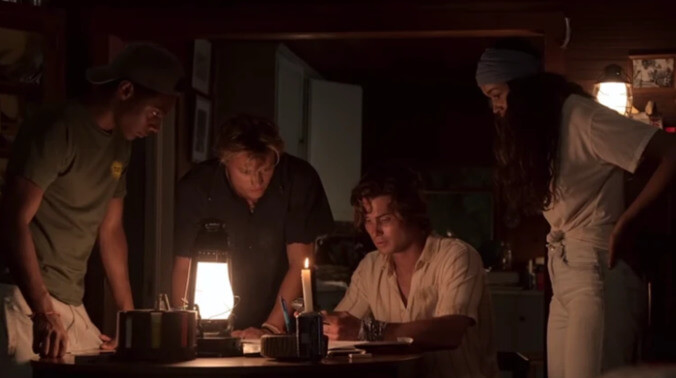Outer Banks hunts for gold but can’t find its footing with female characters


Outer Banks, the new Netflix series about a bunch of teens hunting for long-lost treasure and finding lots of trouble along the way, is incredibly fun. In 10 episodes, it spreads its captivating—if often ludicrous—mystery map, always heightening the tension and packing in enough twists and cliffhangers to make it an easy ride. But the show’s biggest mistake is its tendency to prioritize the hunt over the hunters. Some characters are far more developed than others, and while the acting is solid across the board, weak stabs at transcending tropes and stock types never reach their full potential.
The show unfolds like a high-speed collision of Riverdale, The O.C., and Bloodline. As with Riverdale, there’s a decent amount of over-the-top occurrences that require some suspension of disbelief, as well as a sprawling and somewhat mystifying mythology inherent to this town: Lost gold, shipwrecks, a haunted mansion where a wife supposedly killed her husband. The oceanside town has been corrupted by its heightened class divisions, creating an ongoing cycle of violence.
Visually, the series looks and feels a lot like Bloodline, although the Florida Keys have been traded for the Outer Banks, the wet, hot barrier islands off the coast of North Carolina. But just like Bloodline, the wild and marshy environment seeps into the narrative, acting like a full-on pressure cooker for its characters. At the top of Outer Banks, a hurricane tears through the islands, intensifying an already extremely stratified class structure. Like The O.C. and even Veronica Mars, Outer Banks is sharp in its exploration of class and capitalism and how it impacts day-to-day life but also larger, more zoomed-out cycles for these teens. Outer Banks is particularly interested in the violence of it all.
Protagonist John B (Chase Stokes), an orphaned teen whose father was mysteriously lost at sea in the months before the show begins, leads his band of friends—all Pogues, their shorthand for the working class and poor part of the islands—down the rabbithole of his father’s research on a ship lost at sea containing $400 million worth of British gold. There’s JJ (Rudy Pankow), an oft-stoned hothead with an abusive father. There’s Pope (Jonathan Daviss), whose personality is mostly just the merit scholarship he’s trying to get for college. As far as stock types go, he’s the brains—the smart kid who has a shot at life outside the islands but who keeps getting reeled in by trouble. But Pope is definitely one of those weak spots in Outer Banks’ character development. His relationship with his father is written in broad strokes, despite seemingly being an important part of his motivation. And the breaking point Pope eventually hits feels unearned, especially when stacked up against JJ’s arc, which is much clearer.
The friend group also has one girl: Kiara, known as Kie (Madison Bailey). Her role seems to mostly be to placate the boys when they become violent and also be somewhat sexually available to them and yet also off-limits. John B says so himself in the very minutes of the show: They all have a thing for her. We don’t get much of Kie’s side of this, and it does at times feel like she’s the invention of a distinctly teen boyish fantasy. She’s the cool girl who can hang that the guys also pine over. Kie should be much more engaging and complex as a character, considering her position in the show’s mostly black-and-white class divisions. She is in the gray area, technically a Kook (rich kid) thanks to the financial success of her family’s tourist-bait restaurant, but has chosen to eschew the country club community that she supposedly belongs to in order to run around with Pogues. Outer Banks never digs too deeply into this though, which does Kie a disservice. Her main job as peacemaker plays into some uninspired gender roles.
On the other side, there’s the Kooks: The rich kids, the ruling class. They’re worse than bullies; they’re all-out oppressors. Constantly trying to prove himself to his father and friends, Rafe Cameron (Drew Starkey) is the living embodiment of the real dangers of toxic masculinity and expectations foisted on men. His father, Ward Cameron (Charles Esten), is a Pogue-turned-Kook behind the islands’ biggest development company… so yes, a bad guy. There are definitely differences in how Rafe and Ward both head down a path of destruction, but they’re both similarly driven by the idea of masculinity that they’ve concocted. Outer Banks’ look at class divisions and the patriarchal violence used to enforce them also evokes the Spanish teen soap Élite, although Élite is much stronger in its use and complicating of character tropes.
Rafe’s sister Sarah (Madelyn Cline) is at the heart of Outer Banks’ sweeping teen romance, which is occasionally sweet but not nearly as compelling as the show wants it to be. Between Kie and Sarah, Outer Banks really does seem to have an issue with women. The characters have hints of depth, but they’re brief flashes that never fully pull them out of feeling flat and mostly like they exist merely as supporting roles in the lives of the boys. By the last two episodes, Sarah is clearer in her convictions and motivations, but that’s very late in the game. A few other female characters on the show that are written even worse—like Ward’s wife, a sketch of a stepmom who pops into scenes here and there, always brandishing a glass of wine. Those glasses of wine really are her only personality, and it’s never quite clear how in she is on some of Ward’s business and schemes. When he’s talking to her, he might as well be talking to no one. Sarah’s little sister also gets the broad strokes treatment as a lovesick little girl easily drawn into drama and romance. Sheriff Peterkin, played impeccably by the always incredible Adina Porter, brings a bit of a Western feel to the show’s narrative, the law just on the periphery of the web of crimes, murder, violence, and drugs that are all intertwined. The show attempts to make her ambiguous in the beginning, but then suddenly and emphatically insists on her hero status in a way that feels manipulative and cheap.
Outer Banks slots many of its characters into specific boxes and keeps them there. The series’ lack of nuance sometimes takes away from the emotional stakes, but it still does manage to craft a very exciting mystery-thriller with touches of teen romance. It’s a fun ride, but tighter character work would sell Outer Banks’ biggest moments much harder.